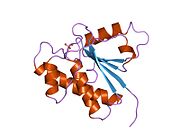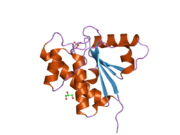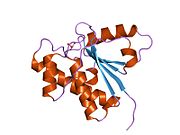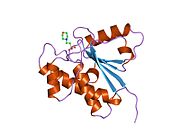ACP1
| ACP1 | |||
|---|---|---|---|
Gene ontology | |||
| Molecular function | |||
| Cellular component | |||
| Biological process | |||
| Sources:Amigo / QuickGO | |||
Ensembl | |||||||||
|---|---|---|---|---|---|---|---|---|---|
| UniProt | |||||||||
| RefSeq (mRNA) | |||||||||
| RefSeq (protein) | |||||||||
| Location (UCSC) | Chr 2: 0.26 – 0.28 Mb | Chr 12: 30.94 – 30.96 Mb | |||||||
| PubMed search | [3] | [4] | |||||||
| View/Edit Human | View/Edit Mouse |
Low molecular weight phosphotyrosine protein phosphatase is an enzyme that in humans is encoded by the ACP1 gene
The product of this gene belongs to the phosphotyrosine protein phosphatase family of proteins. It functions as an acid phosphatase and a protein tyrosine phosphatase by hydrolyzing protein tyrosine phosphate to protein tyrosine and orthophosphate. This enzyme also hydrolyzes orthophosphoric monoesters to alcohol and orthophosphate. This gene is genetically polymorphic, and three common alleles segregating at the corresponding locus give rise to six phenotypes. Each allele appears to encode at least two electrophoretically different isozymes, Bf and Bs, which are produced in allele-specific ratios. Three transcript variants encoding distinct isoforms have been identified for this gene.[5]
Clinical significance
Clinically, increased expression of ACP1 is a biomarker for poor prognosis in prostate cancer has been linked to worse clinical behaviour of prostate cancer, possibly outperforming the widely used
Interactions
ACP1 has been shown to
References
- ^ a b c GRCh38: Ensembl release 89: ENSG00000143727 – Ensembl, May 2017
- ^ a b c GRCm38: Ensembl release 89: ENSMUSG00000044573 – Ensembl, May 2017
- ^ "Human PubMed Reference:". National Center for Biotechnology Information, U.S. National Library of Medicine.
- ^ "Mouse PubMed Reference:". National Center for Biotechnology Information, U.S. National Library of Medicine.
- ^ "Entrez Gene: ACP1 acid phosphatase 1, soluble".
- PMID 26159288.
- PMID 34610471.
- S2CID 3915599.
- S2CID 7383008.
- PMID 31261776.
- PMID 12167657.
- PMID 9499402.
- PMID 19088431.
External links
- Human ACP1 genome location and ACP1 gene details page in the UCSC Genome Browser.
- Overview of all the structural information available in the PDB for UniProt: P24666 (Human Low molecular weight phosphotyrosine protein phosphatase) at the PDBe-KB.
- Overview of all the structural information available in the PDB for UniProt: Q9D358 (Mouse Low molecular weight phosphotyrosine protein phosphatase) at the PDBe-KB.
Further reading
- Junien C, Kaplan JC, Bernheim A, Berger R (April 1979). "Regional assignment of red cell acid phosphatase locus to band 2p25". Human Genetics. 48 (1): 17–21. S2CID 422040.
- Sensabaugh GF, Golden VL (September 1978). "Phenotype dependence in the inhibition of red cell acid phosphatase (ACP) by folates". American Journal of Human Genetics. 30 (5): 553–560. PMID 736044.
- Shekels LL, Smith AJ, Van Etten RL, Bernlohr DA (June 1992). "Identification of the adipocyte acid phosphatase as a PAO-sensitive tyrosyl phosphatase". Protein Science. 1 (6): 710–721. PMID 1304913.
- Wo YY, McCormack AL, Shabanowitz J, Hunt DF, Davis JP, Mitchell GL, Van Etten RL (May 1992). "Sequencing, cloning, and expression of human red cell-type acid phosphatase, a cytoplasmic phosphotyrosyl protein phosphatase". The Journal of Biological Chemistry. 267 (15): 10856–10865. PMID 1587862.
- Dissing J, Johnsen AH (June 1992). "Human red cell acid phosphatase (ACP1): the primary structure of the two pairs of isozymes encoded by the ACP1*A and ACP1*C alleles". Biochimica et Biophysica Acta (BBA) - Protein Structure and Molecular Enzymology. 1121 (3): 261–268. PMID 1627603.
- Dissing J, Johnsen AH, Sensabaugh GF (November 1991). "Human red cell acid phosphatase (ACP1). The amino acid sequence of the two isozymes Bf and Bs encoded by the ACP1*B allele". The Journal of Biological Chemistry. 266 (31): 20619–20625. PMID 1939112.
- Wakita Y, Narahara K, Takahashi Y, Kikkawa K, Kimura S, Oda M, Kimoto H (1986). "Duplication of 2p25: confirmation of the assignment of soluble acid phosphatase (ACP1) locus to 2p25". Human Genetics. 71 (3): 259–260. S2CID 10610694.
- Blake NM, Kirk RL, Barnes KR, Thompson JM (June 1973). "Expression of human red cell acid phosphatase activity in placenta and other tissues". Jinrui Idengaku Zasshi. The Japanese Journal of Human Genetics. 18 (1): 10–23. PMID 4356849.
- Sensabaugh GF, Lazaruk KA (July 1993). "A TaqI site identifies the *A allele at the ACP1 locus". Human Molecular Genetics. 2 (7): 1079. PMID 8364553.
- Bryson GL, Massa H, Trask BJ, Van Etten RL (November 1995). "Gene structure, sequence, and chromosomal localization of the human red cell-type low-molecular-weight acid phosphotyrosyl phosphatase gene, ACP1". Genomics. 30 (2): 133–140. PMID 8586411.
- Tailor P, Gilman J, Williams S, Couture C, Mustelin T (February 1997). "Regulation of the low molecular weight phosphotyrosine phosphatase by phosphorylation at tyrosines 131 and 132". The Journal of Biological Chemistry. 272 (9): 5371–5374. PMID 9038134.
- Stein E, Lane AA, Cerretti DP, Schoecklmann HO, Schroff AD, Van Etten RL, Daniel TO (March 1998). "Eph receptors discriminate specific ligand oligomers to determine alternative signaling complexes, attachment, and assembly responses". Genes & Development. 12 (5): 667–678. PMID 9499402.
- Modesti A, Marzocchini R, Raugei G, Chiti F, Sereni A, Magherini F, Ramponi G (July 1998). "Cloning, expression and characterisation of a new human low Mr phosphotyrosine protein phosphatase originating by alternative splicing". FEBS Letters. 431 (1): 111–115. S2CID 38383291.
- Zhang M, Stauffacher CV, Lin D, Van Etten RL (August 1998). "Crystal structure of a human low molecular weight phosphotyrosyl phosphatase. Implications for substrate specificity". The Journal of Biological Chemistry. 273 (34): 21714–21720. PMID 9705307.
- Tailor P, Gilman J, Williams S, Mustelin T (June 1999). "A novel isoform of the low molecular weight phosphotyrosine phosphatase, LMPTP-C, arising from alternative mRNA splicing". European Journal of Biochemistry. 262 (2): 277–282. PMID 10336608.
- Huang L, Sankar S, Lin C, Kontos CD, Schroff AD, Cha EH, et al. (December 1999). "HCPTPA, a protein tyrosine phosphatase that regulates vascular endothelial growth factor receptor-mediated signal transduction and biological activity". The Journal of Biological Chemistry. 274 (53): 38183–38188. PMID 10608891.
- Nicolas G, Fournier CM, Galand C, Malbert-Colas L, Bournier O, Kroviarski Y, et al. (May 2002). "Tyrosine phosphorylation regulates alpha II spectrin cleavage by calpain". Molecular and Cellular Biology. 22 (10): 3527–3536. PMID 11971983.
- Bottini N, Stefanini L, Williams S, Alonso A, Jascur T, Abraham RT, et al. (July 2002). "Activation of ZAP-70 through specific dephosphorylation at the inhibitory Tyr-292 by the low molecular weight phosphotyrosine phosphatase (LMPTP)". The Journal of Biological Chemistry. 277 (27): 24220–24224. PMID 11976341.
- Bottini N, Ammendola M, Gloria-Bottini F (July 2002). "ACP1 is associated with allergy". Allergy. 57 (7): 651–652. S2CID 42578825.
- Kikawa KD, Vidale DR, Van Etten RL, Kinch MS (October 2002). "Regulation of the EphA2 kinase by the low molecular weight tyrosine phosphatase induces transformation". The Journal of Biological Chemistry. 277 (42): 39274–39279. PMID 12167657.









